Introduction
Alan Richardson has written a series of articles in the
Oxford Journal of Archaeology in which he develops the mathematical basis for determining the size of the Roman camp. He worked from ancient descriptions and from modern archaeological studies of camp sites. The result is a rather elegant rule of thumb that can be used to work out just how big the marching camp needed to be for any given army.
Rules of thumb were probably an important aspect of Roman engineering. Corroborative evidence of the use of rules of thumb exists in other disciplines. A 1995 article by C. V. Walthew titled
Roman Basilicas: a Progress Report (
available at JStor) demonstrates that Roman engineers used some rather simple rules of thumb to determine the size of a basilica based on the diameter of the column drum. There are some interesting similarities. The basilica planning process uses an easily measured variable (the column drum diameter) to establish the dimensions of the entire building. In this way the builder has great flexibility in creating structures of different sizes and yet has a solid set of guidelines. The other similarity is that basilicas were planned from the centerline out, just as were camps.
The camp layout process proposed by Richardson is precisely similar. A single variable, the 'cohort equivalent', (Richardson's term is "notional cohort") determines all of the other dimensions and layout proceeds from the centerline outward.
Roth, incidentally, proposes an exactly analogous rule of thumb, using 'cohort equivalents' to determine the rations for the army (Jonathan Roth,
The Logistics of the Roman Army at War).
Calculating the Size of a Roman Camp
Richardson presents data in number of different ways. Several tables provide specific cohort equivalents for specific types of units such as the
coh. Ped. Quingenaria. But he also gives a somewhat simpler and more direct rule of thumb. All infantry are lumped together and divided by the nominal cohort strength of 480 to establish the number of infantry cohort equivalents. Cavalry are similarly lumped together and divided by 480.
The Roman unit of area is the a.q. (square
actus). The conversion factors are: 1 a.q. = 14400 square
pes (the Roman foot) = 13591.5 square feet = 1262.7 square meters. Camps were laid out in units of a.q.
Each infantry cohort equivalent received 1.5 a.q of actual tenting space. Other space was needed in the camp for officers, animals and streets. This was provided for by increasing the space allocation from 1.5 to 2 a.q, the extra 0.5 a.q being available for the other needs. Each cavalry cohort received double the space of the infantry.
Steps to lay out the dimensions of the camp
- This process can be reduced to a rather simple formula. Count up the infantry and cavalry, double the cavalry, divide the total by 240 (simpler than dividing by 480 then multiplying by 2). This gives the area to be used for the actual camp itself, called the strigified area. Roman camps were either square or rectangular. Richardson notes that, if oblong, the ratio of the sides was 2:3, 3:4, 4:5 or 5:6, with 2:3 being the most common.
- Determine the shape of the camp by selecting an aspect ratio (square would be 1:1)
- Calculate the length of the long and short axis (remember, the Romans laid things out from the center lines not the edges). The formula for this is to take the aspect ratio, most commonly 2:3, multiply the area by it (2/3 times the strigified area, for example) and then take the square root of the product. Multiply the result by the inverted ratio (3/2) to obtain the length of the other axis.
- Calculate the size of the camp fortifications. Between the strigified area and the camp walls there was an open space called the intervallum. Richardson gives the formula for determining the width of this space as 1/8 of the square root of the strigified area. Tables of square roots were known to the Romans so step three was to look up the square root and divide it by 8. This gave the width of the intervallum.
- Determine the overall axis. Simply add the width of the intervallum (Step 4) to both ends of each of axis (from Step 3). The fortifications consisted of a berm with a wall on top and a ditch on the outside. The berm was usually about 30 Roman feet (pedes) wide. There are 120 pedes to the actus, therefore the berm would be 1/4 of an actus in width. Add that to each end of that axis and one has the distance to the entrenchments to be dug.
Calculating the Size of the Generic Army's Camp
The table below shows the 5 steps as they would apply to the Generic Army. (Note: when the term "Generic Army" is used it refers to the army as described in the section on the March. This is because that particular army configuration was rather thoroughly described in detail. The Generic Army does not represent any historical army but rather stands for a more or less typical Roman army.)

Following Richardson's formula, the camp for the Generic Army would have the following dimensions:
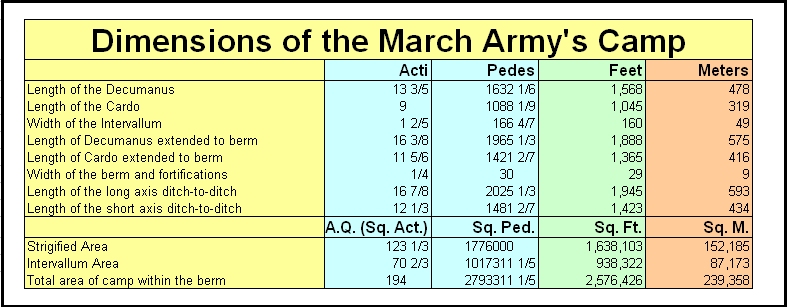
One thing that should be noticed about the Richardson formula is that it does not take into account many of the variables. As was described in the page on
Army Composition, there are many more components to the army than just the cavalry and infantry. Richardson's formula would provide space for those un-specified components by adding the extra space to the cohort allocations.
Is this adequate?
Calculating the space requirements of the Generic Army
It is possible to estimate the space required for the army using more detailed methods. The table below shows space requirements of the Generic Army. The standard military tent was 10x10 and was allocated a space 30 by 12
pedes, 36 sq.
ped. Officer tents are considered to be larger in increments of 2x, 4x and 5x. Tent space for servants and hostages are held to 12 x 18
pedes, 216 sq.
ped. There is no evidence for this, but since these non-combatants did not have the same amount of gear as the soldiers it seems acceptable to allocate them slightly less overall space. Animals are each assigned a space 3x12
pedes, 36 sq.
ped. The exception are animals housed with their units and on the space allocated to that unit -- the
contubernium's mule, for example. Wagons are considered to average about 6 feet wide and 10 feet long, carts about 6x6. In fact there was probably not a standard size for these vehicles.
With those space requirements, the space needed by the Generic Army is calculated below.
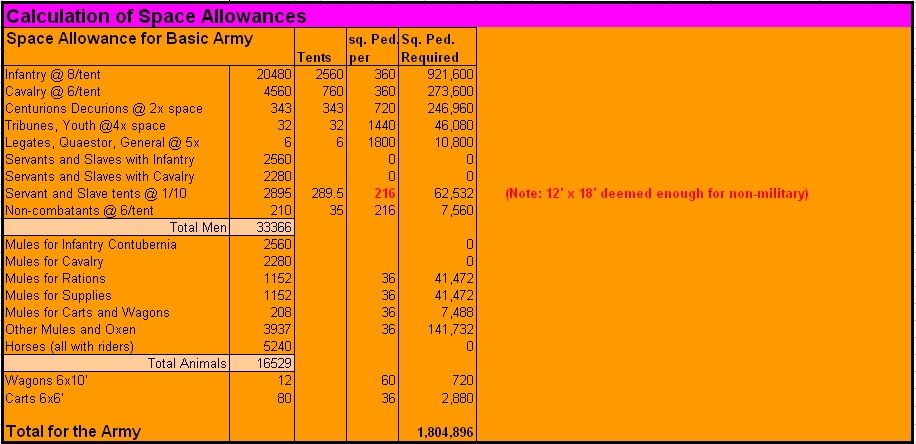
Using the same general space requirements the needs of the additional personnel and equipment are calculated in the next table. In this table the excess grain is stored in tents overnight. It is assumed that one large tent could hold up to 30 mule loads of grain if the grain were packed into regular and similar sized containers that would stack easily. Plunder, being of any size and shape, is deemed to not pack as tightly, only 10 mule loads to the tent. Both food and plunder would have to be unloaded from the mules and stored in tents overnight to protect the food from the elements and the plunder from pilfering.
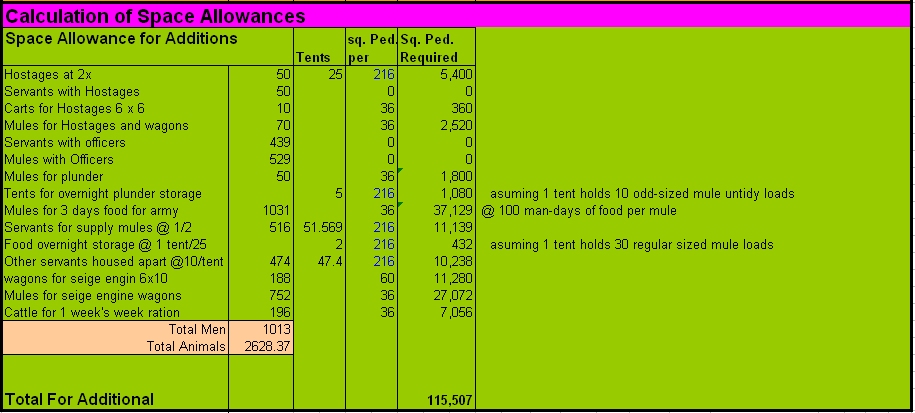
A problem of space
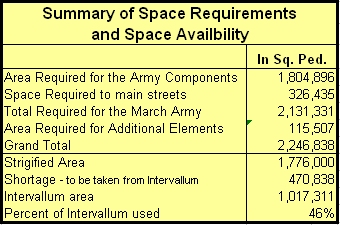
The results of the two sets of calculations are summarized in the table to the right. The army space requirements are at the top, the camp space provided by Richardson's formulas is at the bottom. What is immediately apparent is that the space provided is probably inadequate for the army as described. In addition to the 1.8 million sq.
ped. required by the army is the 326, 435 sq.
ped. needed for the three main streets, two of which were 100
ped. wide, and one of which was 50
ped. wide. Adding this into the total, the army needs just over 2 millions sq.
ped. The Richardson formula provides only 1,776,000 sq.
ped.
When the needs of the additional personnel and equipment are considered the shortfall is even greater.
Three solutions to the problem
- This may point out a weakness in Richardson's formula requiring some revision. His formula well describes known archaeological sites and should not be casually changed. However, it may be that he based it on studies of permanent camps rather than marching camps. Permanent camps would not have the same baggage train requirements. Therefore one solution would be to expand the application of his formula to calculate the cohort equivalents of the baggage train as well.
- Much of the extra space is required for servants and animals. There is some ancient evidence for cattle being kept in the intervallum. It may be possible that baggage animals and at least some of their handlers were also allowed to use that space. The last three lines in the table above show the effects of allowing the overflow to occupy the intervallum. As described, the full army with all of its additional elements would occupy nearly half the intervallum. Intuitively this seems like too great a percentage.
- The third alternative is that the numbers of people, animals, tents and equipment envisioned for the Generic Army are simply too great. But it can be argued that in almost every detail the actual numbers may well have been greater than those estimated for the tables.
The solution that seems most reasonable is the first -- to modify the application of the formulas.. Overall, the "rule of thumb" approach seems good. However, certainly some armies carried with them greater than average quantities of material, be it siege equipment, food, plunder or just general hangers-on. A rule of thumb that rigidly excluded these elements from consideration would not have been practical. And one should probably always think of the Romans as practical, especially in matters of warfare and engineering. Therefore one could argue that the rule should have some mechanism of adjustment to take into account the size of the baggage train and other factors that would significantly affect the space needed such as the presence of large numbers of captives, slaves or hostages; large amounts of plunder; or families and civil servants accompanying the army.
From a purely empirical approach a tentative solution can be suggested by slightly modifying Richardson's formulas. There is no evidence for this approach, it is offered merely as an example of something that
could be done to the formulas to enlarge camp size.
In the Generic Army there are 288 mules per legion assigned to carry food and 288 for non-food equipment, a total of 2,304 mules for the Generic Army. This is considered the army's baggage train. All of the other mules, and there are thousands, are assigned to specific military personnel or to specific military functions. Therefore these 2,304 mules are for general supplies and food. The number could just as well be half or be doubled, depending on just how many supplies as given army carried with it. If Richardson's formula were modified to include a space allocation for the baggage train mules then the overall camp size would be enlarged just enough to accommodate the army.

Previously it was noted that each animal requires about 3 x 12 feet of space. The 2,304 mules require almost 83,000 sq. ft, about 5 3/4 a.q. Since a.q. were arrived at by doubling the cohort equivalents, reversing the process and dividing the space required by 2 gives 2 7/8 cohort equivalents. Dividing the number of mules by this gives us a ratio of 800:1; that is, 800 mules, oxen or horses equal one cohort equivalent.
The Chart on the left shows a simplified method of calculating the camp size. It also slightly adjusts the number of cavalry to include the
evocati and the bodyguards. The space adjustment for the baggage train is in purple. The bottom two lines in the table show that, with the baggage train addition, the total space given by the revised formula is almost identical to the space requirements needed for the Generic Army according to the calculations in the tables above.
As noted above, there is no evidence for making this addition to Richardson's formula. But there is a certain logic to it. Armies would certainly know the size of the baggage train. Since baggage trains could vary in size dramatically it would be reasonable that the camp size should be changed to accommodate them.
The baggage train as described consists almost exclusively of pack animals rather than wagons -- for reasons described elsewhere. If the baggage train were to be made up of large numbers of wagons then a different adjustment formula may be required.
This adjustment for the army's pack train creates a camp large enough to hold the Generic Army itself but not the additional elements that may have been there too. Similar adjustments to the formula could be made for those elements. No general rule of thumb could be suggested since each of the elements in the additional elements table are independently variable. That is, there may or may not be hostages, or plunder, or additional food supplies, or siege engines. Adjustments to the formulas would have to be made independently for each of these factors. Some of those elements are simple additions to the pack train. Others, such as hostages, could require somewhat complicated adjustments if there were a great number of hostages with large amounts of baggage.
The Generic Army camp
With the revised information above the dimensions of the camp for the Generic Army can be recalculated. The table below shows the dimensions of the camp at various aspect ratios.

The illustration below shows the two camp layouts previously presented and the four Generic Army camps at the Aspect Ratios of 1:1, 2:3, 3:4 and 4:5. The illustrations show the strigified area (inner rectangle) and two outer lines representing the inner and outer margins of the berm and defensive wall. The ditch would be excavated just outside of the illustrated rectangles.

The length of the ditch to be dug around the fortifications changes as the aspect ratios change. However the change is insignificant. For the square camp the inner margin of the ditch is 7,246 feet long; for the 2:3 ratio it is 7,361 feet.
In further modeling of the camp of the Generic Army the aspect ratio of 2:3 will be used.
Conclusion
The Richardson formulas provide a useful method by which the Romans may have calculated the size of the camp. His article appears to study permanent camps rather than marching camps. Permanent camps would not have had baggage trains to cope with. For marching camps the formula may need to be adjusted. It appears to be insufficient to accommodate armies that contain large numbers of extraneous men and materials. There are several possible ways in which the problem could be solved but it is possible that the formula may need to be adjusted to take those elements into account. One possible method of making that adjustment would be to add space for the baggage train using a ratio of 800 baggage animals: 1 Cohort Equivalent.
One interesting instance in which Caesar used camp size as a weapon is recorded in the Gallic Wars [5:49]. In an attempt to lure the enemy into an unwise attack on his position, Caesar made his camp as small as possible by reducing the widths of the streets so that the enemy would underestimate the size of his force. This example tells us three things: that the tenting area were already minimized and any space reduction could only from from making the streets narrower; that camps were sized according to the number of men; and most impressively, that the enemy was so well are of the ratio they they could use it to estimate strength.
consedit et quam aequissimo loco potest castra communit atque haec, etsi erant exigua per se vix hominum milium septem praesertim nullis cum impedimentis, tamen angustiis viarum quam maxime potest contrahit, eo consilio, ut in summam contemptionem hostibus veniat.
Camp layout
For the purposes of this section the camp considered will be the
Pseudo-Hyginus camp, the cohort legion's camp. The army used will be the Generic Army as described above. The sub-sections to be considered will be:
Contubernium, the Century, the Cohort, the Legion and finally the Generic Army.
The Contubernium

The basic unit is the
contubernium, the group of tentmates. Earlier a
contubernium of 10 men was considered. However, following the lead of many authorities, the number of men per tent is being lowered from 10 to 8. As noted before, 10 men would hardly fit into the tent. 8 would seem to be a much more realistic number.
The figure at the left shows the "average" Roman soldier used in the illustrations. He stands just under 5'7" tall. His sleeping space is 1"10" wide and 5'7" long. No more than 7 of these sleeping spaces can be arranged inside a ten foot Roman tent (ten
pedes, Roman feet = 9'7") -- see illustration to the right. If one man were on watch then 7 sleeping spaces would be sufficient.
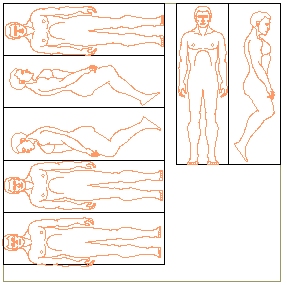
The open space in the corner could have been used for the company's armor and other possessions. Alternatively, baggage as well as the bulky armor may have been kept outside the tent in some type of lean-to shelter.
Each 8 man
contubernium would have one servant who would handle the pack mule. It seems most likely that the company's mule and servant would stay with the
contubernium. The mule would be staked outside the tent. If, indeed, a lean-to was used to protect the company's baggage, then it is also possible that the servant slept in the lean-to, not only to conserve space in the tent but also to act as a guard over the unit's possessions.
If the servant slept in the tent then one would have to postulate that two men were constantly on watch.
The only other alternative is that all of a century's servants were housed separately in their own tent.
The Contubernium's Space
In the Pseudo-Hyginus plan each
contubernium received a space 12
pedes wide by 30
pedes. The space with the tent, mule and lean-to are shown in the illustration below.
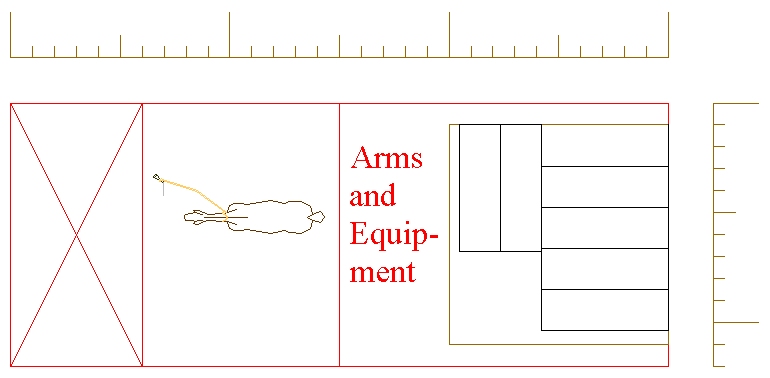
The rectangle is 12
pedes by 30
pedes, as per Richardson. Peddie (
The Roman War Machine) illustrates Hyginus' arrangement in the manner shown above but provides only 12 x 24
pedes. Some 6
pedes on the left, indicated by the X'd out section, are not accounted for. The scale of
pedes is given at both the side and top.
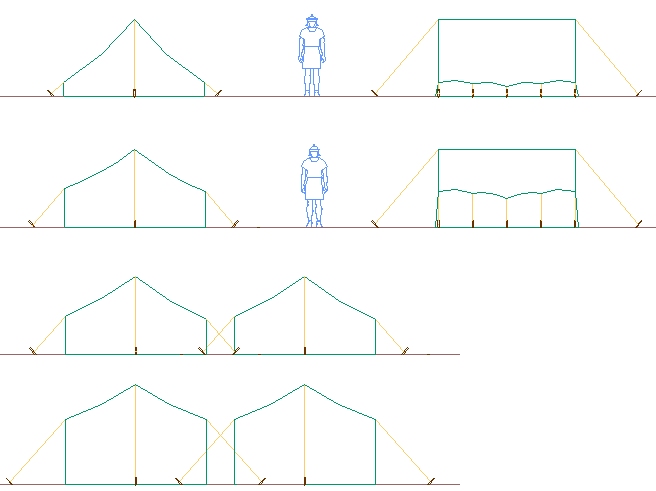
It is interesting to look at the tent itself in a different perspective. There is an ongoing discussion about the tent of the soldiers -- did it have low sides or high sides. Apparently there is evidence pointing in both directions. Several sized of tents are illustrated.
The top tent is the low sided tent. The tent stakes on either side are just 12
pedes apart, meaning that this tent would just fit into the 12
pedesspace allocated.The second tent has higher sides which take the stakes out to a distance of 14
pedes apart. The guy ropes for two tents placed 12
pedes apart would just fit into the space, as illustrated in the third row. Higher sided tents, as illustrated in the bottom row, would not fit. Placed side by side on 12
pedes centers their guy ropes would have to go right through the next tent. This would seem to rule out the use of very high sided tents in marching camps where each
contubernium had only 12
pedes of width allocated to it.
The Contubernium's space:
The illustration below shows the space allocated to the
contubernium. There are several things to note about the image. First is that the tent stakes overlap the space allocated to the tents on either side -- as explained above. Were the other tents shown in this illustration it would be seen that they crisscross each other.
The 8 soldiers of the
contubernium are shown in their half of the street which would separate this tent site from the one across from it. The width of the street is just sufficient to let the 8 men must into a 2 abreast marching formation.
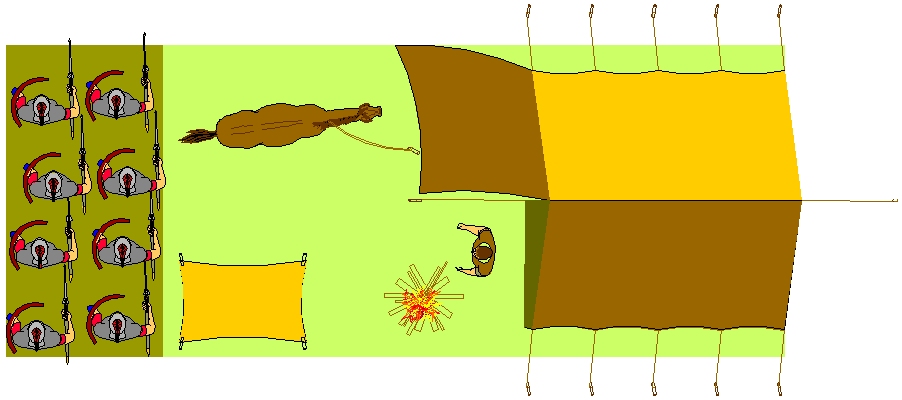
The tent area shows a lean-to against the front of the tent for the servant and for supplies. A tan square in the lower section represents additional camp supplies being stored under a leather tarp. The
contubernium's servant, who has care for the supplies and mule, is shown standing next to the fire, just outside the tent. Not shown are the piles of firewood and animal feed that would clutter the little open space.
The acute observer will note the tent rope and stake off to the right. If tents were pitched back to back this rope would be a problem. One solution would be to move the tent further forward into the allocated space to make room, but as can be seen, the allocated space is already quite small for 9 men and a mule. The solution suggested is that the two back-to-back tents were tied together to mutually support each other, eliminating the rope altogether.
The Centuria's space
Putting 10
contubernia together and adding the centurion at the end of the row gives us the actual space required for a century. The centurion is allocated double the space of the
contubernium. His tent, though illustrated at the same size as the others, has higher side walls, requiring longer guy ropes on either side. He has two mules and a correspondingly larger amount of personal possessions stored under tarp.

Centuries were arranged with their tents back to back and with a street between facing tents. Putting three centuries together in the illustration below begins to give an idea of what the Roman camp would have been like. In the area represented below some 243 men and 36 mules would have camped. The sounds and smells of this congested place can hardly be imagined.

The Uncounted Men
At this point it is necessary to make a brief aside and discuss the uncounted men. The century had a second officer, the
optio, a standard bearer, the
signifer, and a musician, either a
tubicen or a
bucinator. What is lacking is information about just where these men came from and where they tented.
If one considers the century as 80 infantry men plus the centurion, the
optio, the
signifer and the
aeneator then the total strength is 84. Tents for the other 4 men must be provided. In that case, the
signiferi and
aeneatores from all the centuries could be housed together in some central location, presumably near the general's tent. The
optio would, presumably, have a tent of his own.
The other alternative is that the
optio,
signifer and
aeneator were a part of the 80 men of the century itself. That is the option selected for these illustrations. These three men are housed in with the balance of the century and no special tents are provided. There are two arguments in favor of this alternative. When the century mustered for marching or for fighting it would assemble around its standard and depend on its musician for signals. If these men were centrally housed then the century would have to link up with these components somewhere inside the camp. For an army of 4 legions there would be 240 centuries, plus similar units for the cavalry. The task of trying to coordinate the link-up of all of these units together would be formidable. There would be enormous potential for delays and even chaos.
The more general argument is that the Roman army did not tend to add on personnel for special functions. Artillerymen and medical corpsmen were in large part drawn from the infantry; that is, they were fighting soldiers with special functions. It is somewhat more in keeping with this overall trend that the musicians and standard bearers would also be a part of the regular infantry. But the reader should keep in mind that this is highly speculative since we have very little evidence.
The cavalryman's space
One
ala was either 480 men (if the
turma was 30 men) and 512 men if the
turma was 32 men (Richardson, 2001). He allocates the
ala twice the 1.5 a.q. assigned to the 480 man cohort. The
turma was assigned a length of 3/4 an
actus x 1/4
actus, 90
pedes x 30
pedes. If the
turma was comprised of 32 men at 8 to the tent then there would be 4 tent sites to the 90
pedes. A single tent site is shown below.
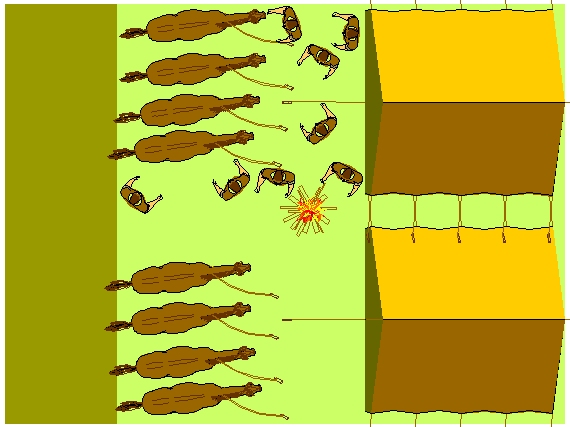
The first thing to be noticed is that there are two tents on the site. That is necessary because of the larger ratio of servants to fighting men in the cavalry. Some have the ratio as high as 1:1. According to the
March Army analysis, the 32 man
turma would have 27 servants to handle its pack train.
The illustration at the left shows 8 servants, a 1:1 ratio. Were the ratio to be lower, only 7 servants would be shown. However, they would still require a tent of their own.
The 8 horses for the cavalry men are shown picketed at the site.
What is not shown are the 7 pack animals. Clearly, there is not enough space for these animals to be kept in the area assigned, they must be given space elsewhere in the camp.
The Turma's Space
The illustration below shows the 4 tent sites of the soldiers combined with the tent of the
turma commander.

Standard camp illustrations
In an earlier section on the
Roman Camp two styles of camp were illustrated: one described by Polybius and one by Pseudo-Hyginus. Polybius describes a camp for the Roman army as it was constituted before the re-organization into cohorts usually attributed to Marius. Pseudo-Hyginus describes camps for the cohort legions, probably those of the 1st to 3rd centuries AD.
Books typicall illustrate the Roman camp with but one of two illustrations. The source illustration for the Polybius camp seems to have come from the Journal of Roman Studies xxii, 1932. All illustrations of this camp clearly use this one source, even where minor changes are made. The source illustration for the Pseudo-Hyginus camp is not known but again, it is clear that all illustrations of this camp also descend from a common source.
In the previous section attention was called to the fact that the later camp allows less room per soldier and that authors seem not to take note of this fact. This oversight was corrected in the articles by Richardson (cited below). He believes the reduced space indicates a higher level of professionalism in the army.
Some sources using the Polybius camp illustration are:
The Military Institutions of the Romans (a translation of Vegetius),
The Making of the Roman Army,
Greece and Rome at War,
A History of Rome to the Death of Caesar, and
A History of Rome by Cary. Some sources using the Pseudo-Hyginus camp illustration are:
Caesar by Dodge, Caesar's Gallic Wars (A Latin text), Richardson's articles, T
he Roman War Machine, and
Caesar's Army.
All illustrations should be viewed with considerable caution. As the following sections on Richardson's articles will demonstrate, camp size depended on the size of the army. Surely the exact arrangement of tents within the camp changed from time to time, with different commanders, and as the composition of the encamping force changed. Camps were never as precisely laid out as the illustrations would have one believe. Some authors have even stated that each soldier slept in exactly the same position in the camp every night. In case of a night attack he would know exactly where he was and where his duty station was. While this sounds impressive, it cannot have been true. As the size of the camp changed the internal arrangement of the tents would have to change. And the size of the army to be encamped would change often as men died, units were dispatched to other activities, supplies built up or dissipated, hospital space for wounded expanded or contracted. Soldiers could not have a constant assigned position.
 Following Richardson's formula, the camp for the Generic Army would have the following dimensions:
Following Richardson's formula, the camp for the Generic Army would have the following dimensions:
 One thing that should be noticed about the Richardson formula is that it does not take into account many of the variables. As was described in the page on Army Composition, there are many more components to the army than just the cavalry and infantry. Richardson's formula would provide space for those un-specified components by adding the extra space to the cohort allocations.
Is this adequate?
One thing that should be noticed about the Richardson formula is that it does not take into account many of the variables. As was described in the page on Army Composition, there are many more components to the army than just the cavalry and infantry. Richardson's formula would provide space for those un-specified components by adding the extra space to the cohort allocations.
Is this adequate?
 Using the same general space requirements the needs of the additional personnel and equipment are calculated in the next table. In this table the excess grain is stored in tents overnight. It is assumed that one large tent could hold up to 30 mule loads of grain if the grain were packed into regular and similar sized containers that would stack easily. Plunder, being of any size and shape, is deemed to not pack as tightly, only 10 mule loads to the tent. Both food and plunder would have to be unloaded from the mules and stored in tents overnight to protect the food from the elements and the plunder from pilfering.
Using the same general space requirements the needs of the additional personnel and equipment are calculated in the next table. In this table the excess grain is stored in tents overnight. It is assumed that one large tent could hold up to 30 mule loads of grain if the grain were packed into regular and similar sized containers that would stack easily. Plunder, being of any size and shape, is deemed to not pack as tightly, only 10 mule loads to the tent. Both food and plunder would have to be unloaded from the mules and stored in tents overnight to protect the food from the elements and the plunder from pilfering.

 The results of the two sets of calculations are summarized in the table to the right. The army space requirements are at the top, the camp space provided by Richardson's formulas is at the bottom. What is immediately apparent is that the space provided is probably inadequate for the army as described. In addition to the 1.8 million sq. ped. required by the army is the 326, 435 sq. ped. needed for the three main streets, two of which were 100 ped. wide, and one of which was 50 ped. wide. Adding this into the total, the army needs just over 2 millions sq. ped. The Richardson formula provides only 1,776,000 sq. ped.
When the needs of the additional personnel and equipment are considered the shortfall is even greater.
The results of the two sets of calculations are summarized in the table to the right. The army space requirements are at the top, the camp space provided by Richardson's formulas is at the bottom. What is immediately apparent is that the space provided is probably inadequate for the army as described. In addition to the 1.8 million sq. ped. required by the army is the 326, 435 sq. ped. needed for the three main streets, two of which were 100 ped. wide, and one of which was 50 ped. wide. Adding this into the total, the army needs just over 2 millions sq. ped. The Richardson formula provides only 1,776,000 sq. ped.
When the needs of the additional personnel and equipment are considered the shortfall is even greater.
 Previously it was noted that each animal requires about 3 x 12 feet of space. The 2,304 mules require almost 83,000 sq. ft, about 5 3/4 a.q. Since a.q. were arrived at by doubling the cohort equivalents, reversing the process and dividing the space required by 2 gives 2 7/8 cohort equivalents. Dividing the number of mules by this gives us a ratio of 800:1; that is, 800 mules, oxen or horses equal one cohort equivalent.
The Chart on the left shows a simplified method of calculating the camp size. It also slightly adjusts the number of cavalry to include the evocati and the bodyguards. The space adjustment for the baggage train is in purple. The bottom two lines in the table show that, with the baggage train addition, the total space given by the revised formula is almost identical to the space requirements needed for the Generic Army according to the calculations in the tables above.
As noted above, there is no evidence for making this addition to Richardson's formula. But there is a certain logic to it. Armies would certainly know the size of the baggage train. Since baggage trains could vary in size dramatically it would be reasonable that the camp size should be changed to accommodate them.
The baggage train as described consists almost exclusively of pack animals rather than wagons -- for reasons described elsewhere. If the baggage train were to be made up of large numbers of wagons then a different adjustment formula may be required.
This adjustment for the army's pack train creates a camp large enough to hold the Generic Army itself but not the additional elements that may have been there too. Similar adjustments to the formula could be made for those elements. No general rule of thumb could be suggested since each of the elements in the additional elements table are independently variable. That is, there may or may not be hostages, or plunder, or additional food supplies, or siege engines. Adjustments to the formulas would have to be made independently for each of these factors. Some of those elements are simple additions to the pack train. Others, such as hostages, could require somewhat complicated adjustments if there were a great number of hostages with large amounts of baggage.
Previously it was noted that each animal requires about 3 x 12 feet of space. The 2,304 mules require almost 83,000 sq. ft, about 5 3/4 a.q. Since a.q. were arrived at by doubling the cohort equivalents, reversing the process and dividing the space required by 2 gives 2 7/8 cohort equivalents. Dividing the number of mules by this gives us a ratio of 800:1; that is, 800 mules, oxen or horses equal one cohort equivalent.
The Chart on the left shows a simplified method of calculating the camp size. It also slightly adjusts the number of cavalry to include the evocati and the bodyguards. The space adjustment for the baggage train is in purple. The bottom two lines in the table show that, with the baggage train addition, the total space given by the revised formula is almost identical to the space requirements needed for the Generic Army according to the calculations in the tables above.
As noted above, there is no evidence for making this addition to Richardson's formula. But there is a certain logic to it. Armies would certainly know the size of the baggage train. Since baggage trains could vary in size dramatically it would be reasonable that the camp size should be changed to accommodate them.
The baggage train as described consists almost exclusively of pack animals rather than wagons -- for reasons described elsewhere. If the baggage train were to be made up of large numbers of wagons then a different adjustment formula may be required.
This adjustment for the army's pack train creates a camp large enough to hold the Generic Army itself but not the additional elements that may have been there too. Similar adjustments to the formula could be made for those elements. No general rule of thumb could be suggested since each of the elements in the additional elements table are independently variable. That is, there may or may not be hostages, or plunder, or additional food supplies, or siege engines. Adjustments to the formulas would have to be made independently for each of these factors. Some of those elements are simple additions to the pack train. Others, such as hostages, could require somewhat complicated adjustments if there were a great number of hostages with large amounts of baggage.
 The illustration below shows the two camp layouts previously presented and the four Generic Army camps at the Aspect Ratios of 1:1, 2:3, 3:4 and 4:5. The illustrations show the strigified area (inner rectangle) and two outer lines representing the inner and outer margins of the berm and defensive wall. The ditch would be excavated just outside of the illustrated rectangles.
The illustration below shows the two camp layouts previously presented and the four Generic Army camps at the Aspect Ratios of 1:1, 2:3, 3:4 and 4:5. The illustrations show the strigified area (inner rectangle) and two outer lines representing the inner and outer margins of the berm and defensive wall. The ditch would be excavated just outside of the illustrated rectangles.
 The length of the ditch to be dug around the fortifications changes as the aspect ratios change. However the change is insignificant. For the square camp the inner margin of the ditch is 7,246 feet long; for the 2:3 ratio it is 7,361 feet.
In further modeling of the camp of the Generic Army the aspect ratio of 2:3 will be used.
The length of the ditch to be dug around the fortifications changes as the aspect ratios change. However the change is insignificant. For the square camp the inner margin of the ditch is 7,246 feet long; for the 2:3 ratio it is 7,361 feet.
In further modeling of the camp of the Generic Army the aspect ratio of 2:3 will be used.
 The basic unit is the contubernium, the group of tentmates. Earlier a contubernium of 10 men was considered. However, following the lead of many authorities, the number of men per tent is being lowered from 10 to 8. As noted before, 10 men would hardly fit into the tent. 8 would seem to be a much more realistic number.
The figure at the left shows the "average" Roman soldier used in the illustrations. He stands just under 5'7" tall. His sleeping space is 1"10" wide and 5'7" long. No more than 7 of these sleeping spaces can be arranged inside a ten foot Roman tent (ten pedes, Roman feet = 9'7") -- see illustration to the right. If one man were on watch then 7 sleeping spaces would be sufficient.
The basic unit is the contubernium, the group of tentmates. Earlier a contubernium of 10 men was considered. However, following the lead of many authorities, the number of men per tent is being lowered from 10 to 8. As noted before, 10 men would hardly fit into the tent. 8 would seem to be a much more realistic number.
The figure at the left shows the "average" Roman soldier used in the illustrations. He stands just under 5'7" tall. His sleeping space is 1"10" wide and 5'7" long. No more than 7 of these sleeping spaces can be arranged inside a ten foot Roman tent (ten pedes, Roman feet = 9'7") -- see illustration to the right. If one man were on watch then 7 sleeping spaces would be sufficient.
 The open space in the corner could have been used for the company's armor and other possessions. Alternatively, baggage as well as the bulky armor may have been kept outside the tent in some type of lean-to shelter.
Each 8 man contubernium would have one servant who would handle the pack mule. It seems most likely that the company's mule and servant would stay with thecontubernium. The mule would be staked outside the tent. If, indeed, a lean-to was used to protect the company's baggage, then it is also possible that the servant slept in the lean-to, not only to conserve space in the tent but also to act as a guard over the unit's possessions.
If the servant slept in the tent then one would have to postulate that two men were constantly on watch.
The only other alternative is that all of a century's servants were housed separately in their own tent.
The open space in the corner could have been used for the company's armor and other possessions. Alternatively, baggage as well as the bulky armor may have been kept outside the tent in some type of lean-to shelter.
Each 8 man contubernium would have one servant who would handle the pack mule. It seems most likely that the company's mule and servant would stay with thecontubernium. The mule would be staked outside the tent. If, indeed, a lean-to was used to protect the company's baggage, then it is also possible that the servant slept in the lean-to, not only to conserve space in the tent but also to act as a guard over the unit's possessions.
If the servant slept in the tent then one would have to postulate that two men were constantly on watch.
The only other alternative is that all of a century's servants were housed separately in their own tent.
 The rectangle is 12 pedes by 30 pedes, as per Richardson. Peddie ( The Roman War Machine) illustrates Hyginus' arrangement in the manner shown above but provides only 12 x 24 pedes. Some 6 pedes on the left, indicated by the X'd out section, are not accounted for. The scale of pedes is given at both the side and top.
The rectangle is 12 pedes by 30 pedes, as per Richardson. Peddie ( The Roman War Machine) illustrates Hyginus' arrangement in the manner shown above but provides only 12 x 24 pedes. Some 6 pedes on the left, indicated by the X'd out section, are not accounted for. The scale of pedes is given at both the side and top.
 It is interesting to look at the tent itself in a different perspective. There is an ongoing discussion about the tent of the soldiers -- did it have low sides or high sides. Apparently there is evidence pointing in both directions. Several sized of tents are illustrated.
The top tent is the low sided tent. The tent stakes on either side are just 12 pedes apart, meaning that this tent would just fit into the 12 pedesspace allocated.The second tent has higher sides which take the stakes out to a distance of 14 pedes apart. The guy ropes for two tents placed 12 pedes apart would just fit into the space, as illustrated in the third row. Higher sided tents, as illustrated in the bottom row, would not fit. Placed side by side on 12 pedes centers their guy ropes would have to go right through the next tent. This would seem to rule out the use of very high sided tents in marching camps where each contubernium had only 12 pedes of width allocated to it.
It is interesting to look at the tent itself in a different perspective. There is an ongoing discussion about the tent of the soldiers -- did it have low sides or high sides. Apparently there is evidence pointing in both directions. Several sized of tents are illustrated.
The top tent is the low sided tent. The tent stakes on either side are just 12 pedes apart, meaning that this tent would just fit into the 12 pedesspace allocated.The second tent has higher sides which take the stakes out to a distance of 14 pedes apart. The guy ropes for two tents placed 12 pedes apart would just fit into the space, as illustrated in the third row. Higher sided tents, as illustrated in the bottom row, would not fit. Placed side by side on 12 pedes centers their guy ropes would have to go right through the next tent. This would seem to rule out the use of very high sided tents in marching camps where each contubernium had only 12 pedes of width allocated to it.
 The tent area shows a lean-to against the front of the tent for the servant and for supplies. A tan square in the lower section represents additional camp supplies being stored under a leather tarp. The contubernium's servant, who has care for the supplies and mule, is shown standing next to the fire, just outside the tent. Not shown are the piles of firewood and animal feed that would clutter the little open space.
The acute observer will note the tent rope and stake off to the right. If tents were pitched back to back this rope would be a problem. One solution would be to move the tent further forward into the allocated space to make room, but as can be seen, the allocated space is already quite small for 9 men and a mule. The solution suggested is that the two back-to-back tents were tied together to mutually support each other, eliminating the rope altogether.
The tent area shows a lean-to against the front of the tent for the servant and for supplies. A tan square in the lower section represents additional camp supplies being stored under a leather tarp. The contubernium's servant, who has care for the supplies and mule, is shown standing next to the fire, just outside the tent. Not shown are the piles of firewood and animal feed that would clutter the little open space.
The acute observer will note the tent rope and stake off to the right. If tents were pitched back to back this rope would be a problem. One solution would be to move the tent further forward into the allocated space to make room, but as can be seen, the allocated space is already quite small for 9 men and a mule. The solution suggested is that the two back-to-back tents were tied together to mutually support each other, eliminating the rope altogether.
 Centuries were arranged with their tents back to back and with a street between facing tents. Putting three centuries together in the illustration below begins to give an idea of what the Roman camp would have been like. In the area represented below some 243 men and 36 mules would have camped. The sounds and smells of this congested place can hardly be imagined.
Centuries were arranged with their tents back to back and with a street between facing tents. Putting three centuries together in the illustration below begins to give an idea of what the Roman camp would have been like. In the area represented below some 243 men and 36 mules would have camped. The sounds and smells of this congested place can hardly be imagined.

 The first thing to be noticed is that there are two tents on the site. That is necessary because of the larger ratio of servants to fighting men in the cavalry. Some have the ratio as high as 1:1. According to the March Army analysis, the 32 man turma would have 27 servants to handle its pack train.
The illustration at the left shows 8 servants, a 1:1 ratio. Were the ratio to be lower, only 7 servants would be shown. However, they would still require a tent of their own.
The 8 horses for the cavalry men are shown picketed at the site.
What is not shown are the 7 pack animals. Clearly, there is not enough space for these animals to be kept in the area assigned, they must be given space elsewhere in the camp.
The first thing to be noticed is that there are two tents on the site. That is necessary because of the larger ratio of servants to fighting men in the cavalry. Some have the ratio as high as 1:1. According to the March Army analysis, the 32 man turma would have 27 servants to handle its pack train.
The illustration at the left shows 8 servants, a 1:1 ratio. Were the ratio to be lower, only 7 servants would be shown. However, they would still require a tent of their own.
The 8 horses for the cavalry men are shown picketed at the site.
What is not shown are the 7 pack animals. Clearly, there is not enough space for these animals to be kept in the area assigned, they must be given space elsewhere in the camp.


3 comments
Alan, is it possible that the Roman Dodecahedron could have been used to ray trace from it’s geometry to lay out a golden rectangle for the camps? The dodecahedron contains multiple ways of obtaining the golden ratio. Same thing with the icosahedron which is dual to the icosahedron. These objects are hand sized and using twine wrapped around the nibs the holder could feel angular tension very easily from a soldier walking the twine out to post points.
Absolutely FIRE 🤑🤑🤑🤑🤑🤑🤑🤑🤑🤑🤑🤑🤑 Helped out with my school project 🤑🤑🤑🤑🤑🤑🤑🤑🤑🤑🤑🤑🤑🤑🤑🤑🤑🤑🤑🤑🤑🤑🤑🤑🤑🤑🤑🤑🤑🤑🤑🤑🤑🤑🤑🤑🤑🤑🤑🤑🤑🤑🤑🤑🤑🤑🤑🤑🤑🤑🤑🤑🤑🤑🤑🤑🤑🤑🤑🤑🤑🤑🤑🤑🤑🤑🤑🤑🤑🤑🤑🤑🤑🤑🤑🤑🤑🤑🤑🤑🤑🤑🤑🤑🤑🤑🤑🤑🤑🤑🤑🤑🤑🤑🤑🤑🤑🤑🤑🤑🤑🤑🤑🤑🤑🤑🤑🤑🤑🤑🤑🤑🤑🤑🤑🤑🤑🤑🤑🤑🤑🤑🤑🤑🤑🤑🤑🤑🤑🤑🤑🤑🤑🤑🤑🤑🤑🤑🤑🤑🤑🤑🤑🤑🤑🤑🤑🤑🤑🤑🤑🤑🤑🤑🤑🤑🤑🤑🤑🤑🤑🤑🤑🤑🤑🤑🤑🤑🤑🤑🤑🤑🤑🤑🤑🤑🤑🤑🤑🤑🤑🤑🤑🤑🤑🤑🤑🤑🤑🤑🤑🤑🤑🤑🤑🤑🤑🤑🤑🤑🤑🤑🤑🤑🤑🤑🤑🤑🤑🤑🤑🤑🤑🤑🤑🤑🤑🤑🤑🤑🤑🤑🤑🤑🤑🤑🤑🤑🤑🤑🤑🤑🤑🤑🤑🤑🤑🤑🤑🤑🤑🤑🤑🤑🤑🤑🤑🤑🤑🤑🤑🤑🤑🤑🤑🤑🤑🤑🤑🤑🤑🤑🤑🤑🤑🤑🤑🤑🤑🤑🤑🤑🤑
I am delighted you are taking my work seriously. I am now 82 and very rusty in the brain but I wish you good luck.